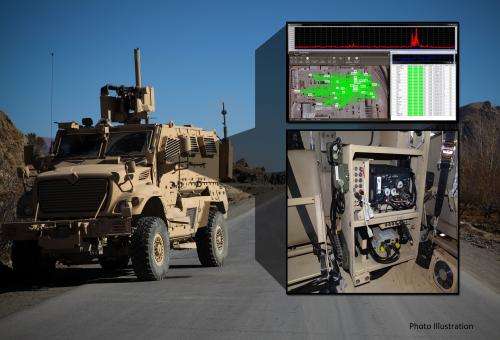Radio gateway connects US and allied troops to a common mobile network

Multinational forces, U.S. government agencies and U.S. troops operating together in forward-deployed locations generally have problems communicating—and not just due to language differences. Technical incompatibility between communications systems can hinder information sharing and timely command and control decisions. DARPA's Mobile Ad hoc Interoperability Network Gateway (MAINGATE) program is helping overcome this technology barrier. The program is nearing completion and plans to transfer the latest version of the system to Army warfighters still engaged in Afghanistan, but who are now focused more on Force Protection as U.S. forces draw down. The MAINGATE system is providing insights into tactical networking of the future, where systems will need more adaptability and capability. The system is packaged in a way that provides real-world capabilities like no other existing system.
The MAINGATE system combines two advanced technologies to provide a reliable, interoperable network for connecting current and future forces from the tactical edge. The first technology is MAINGATE's high capacity Wireless IP Network (WIPN) radio, which provides a terrestrial "Everything over IP" backbone with ample capacity to support multiple channels of voice, video and data. The second technology is MAINGATE's Interoperability Gateway, which provides interconnectivity for users with incompatible communications equipment. The MAINGATE system provides a tactical mid-tier communications capability between front-line troops and organizations, and the higher-level systems like the Army's Warfighter Information Network – Tactical (WIN-T) infrastructure.
"MAINGATE is designed to be a potent communications force multiplier for joint and combined forces," said Keith Gremban, DARPA program manager. "From a radio perspective, MAINGATE allows coalition forces to plug in their own radio systems and MAINGATE takes the necessary steps so everyone can communicate in real time."
DARPA has been developing MAINGATE since 2008, and various elements of the technology have already made their way into existing U.S. Army systems. Army brigade-level exercises have tested a number of MAINGATE units, as have operational trials with U.S. and coalition forces in Afghanistan. The system has already proven its worth; during a recent operational deployment in Afghanistan, MAINGATE enabled sharing of data between different coalition partners' systems so a commander in the base defense operations center could view a video feed of an attempted base intrusion as it occurred. That sort of real-time coordination wasn't possible before.
A key feature of MAINGATE is that it is designed to be upgradeable to future technologies, so the system stays current with the latest commercial IP-based communications tech refresh. This design flexibility allows advances in military and commercial systems to quickly integrate state-of-the-art capabilities to the front-line troops, something that is tremendously challenging for current tactical systems.
Beyond supporting U.S. and coalition forces, MAINGATE has the potential to support civilian first responders in crisis situations where multiple agencies and organizations converge with often incompatible communications systems. With MAINGATE, they could all plug in and communicate on a common network.
"We're transitioning a proven capability that can be kept up to date with the latest IP technology standards," Gremban said. "Just as a smartphone offers the capability to do more than make phone calls, MAINGATE is much more than a radio—it's a backbone architecture enabling video, data and voice sharing among a diversity of networks and devices."
Provided by DARPA



















